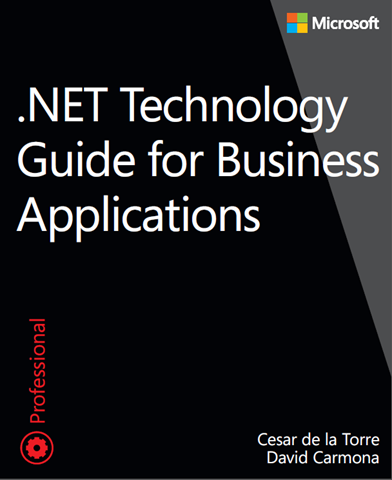Just released our .NET Business Applications Technology Guide (MS PRESS eBook)
What is this guide / eBook about?
UPDATE – Dec.2013
This same Guide has been published now as free MS PRESS eBook, here:
—
A few days ago (late June 2013, at BUILD) we released a new paper showing a global and broad picture of Microsoft development technologies for custom LOB applications.
Download: http://www.microsoft.com/net/nettechnologyguidance
The Microsoft portfolio of development technologies is pretty large and it’s applicable to many software development scenarios across different industries. It is also continuously evolving and growing. Professionals who are involved in software application development might find it difficult to navigate this large portfolio without high-level guidance on technology positioning and selection.
This paper provides guidance on how to effectively select the right Microsoft development technologies and approaches for your custom application development; depending on the priorities you have for your application and for your business domain.
In order to position development technologies it also recommends different scenarios and approaches based on the application priorities, like Data-Driven application, Domain-Driven application, and also by UI- type (web, store-app, mobile, desktop, etc.).
How to use it?
This guide covers a broad spectrum of software development options that focus on business applications. It is written as a reference, so you can go straight to the area you are interested in, such as “Emerging Application Patterns” or “Established Application Patterns.”
MODERN BUSINESS APPLICATIONS
The guide is divided in three main sections:
– Overview (Introduction to Microsoft development story)
– Emerging Application Patterns (Modern Business Applications)
o Devices
o Services
– Established Application Patterns
o Small/Medium Business Applications
o Large Mission-Critical Business Applications
Each of those sections has tables covering the different technologies categorized on the following areas:
– Native UI technologies (Windows Store apps, Desktop, etc.)
– Web technologies
– Services, cloud and back-end technologies
Additionally, we’re pointing to useful approaches depending on the type of application you want to create, like RADs approaches for small/medium Data-Driven apps, or Domain-Driven Design approaches for Core Business/Domain and Mission-Critical applications.
The first time you use this guidance, it is recommended to read the initial introduction section, which explains the vision of the guide and its backbone. Afterwards, you can directly go to the section you are interested on based on you application priorities and categorization.
If you have any feedback about this paper, please, send me direct feedback to CESARDL at MICROSOFT.COM


 Light
Light Dark
Dark
0 comments